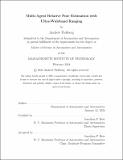Multi-Agent Relative Pose Estimation with Ultra-Wideband Ranging
Author(s)
Fishberg, Andrew
DownloadThesis PDF (26.27Mb)
Advisor
How, Jonathan P.
Terms of use
Metadata
Show full item recordAbstract
Inter-agent relative localization is critical for any multi-robot system operating in the absence of external positioning infrastructure or prior environmental knowledge. Motivated by the applications of nuclear non-proliferation, radiological search, and radiological mapping, this thesis explores leveraging multiple ultra-wideband (UWB) ranging sensors to produce frequent inter-agent pose estimates with minimal communication overhead. This work is intended as a component of a larger multi-agent simultaneous localization and mapping (SLAM) system (also known as collaborative SLAM or CSLAM), where persistent UWB-based inter-agent pose estimates provide a valuable alternative source of inter-agent loop closures. By collecting and analyzing real data, we develop improved sensor models, which in turn inform our algorithm design process– thus, this work produces competitive or improved results to state-of-the-art approaches with significantly less overall communication. By comparison, prior work typically supplements noisy UWB range measurements with additional continuously transmitted data, such as odometry, leading to potential scaling issues with increased team size and/or decreased communication network capability.
This thesis’s main technical contributions are as follows: (1) Exploration of current commercially available off-the-shelf (COTS) UWB devices for use in mobile robotics. Byanalyzing real data, insights into commonly overlooked sensor quirks are addressed through our improved sensor models. (2) Development and testing of a novel 2D relative pose estimation system based on trilateration, leveraging multiple UWB ranging sensors per agent. (3) Extension of said system to 3D environments. (4) A list of recommendations and continuations for future work.
Date issued
2024-02Department
Massachusetts Institute of Technology. Department of Aeronautics and AstronauticsPublisher
Massachusetts Institute of Technology